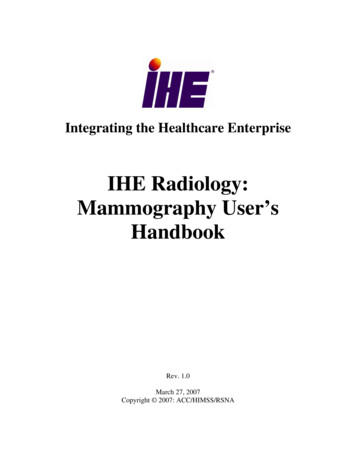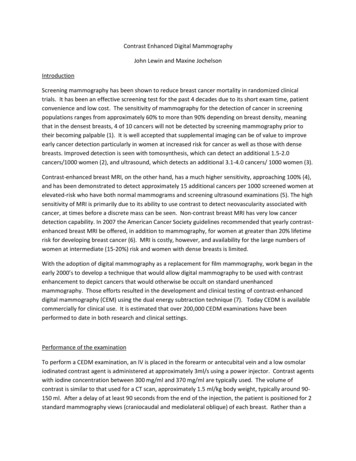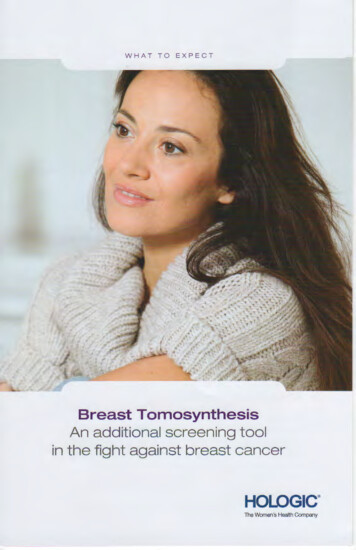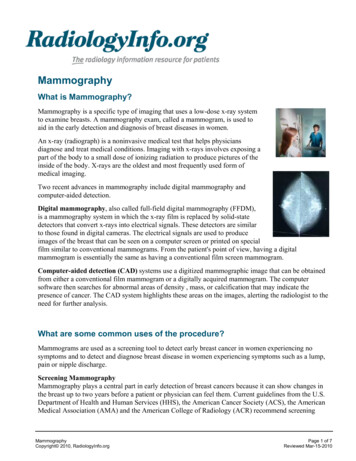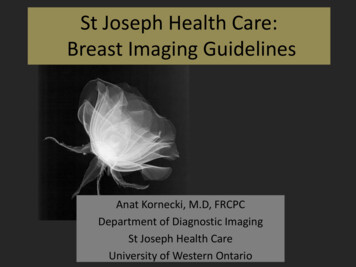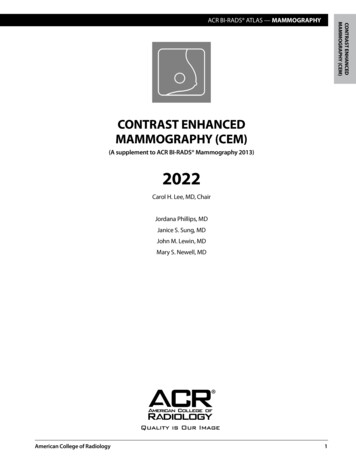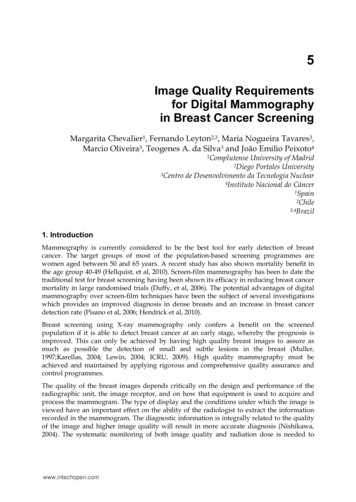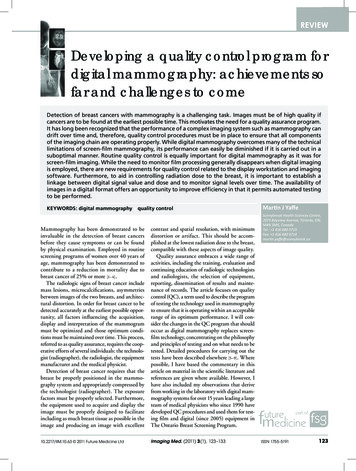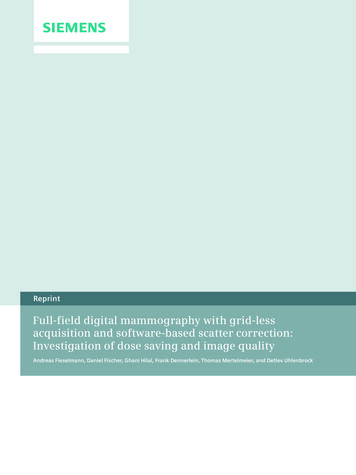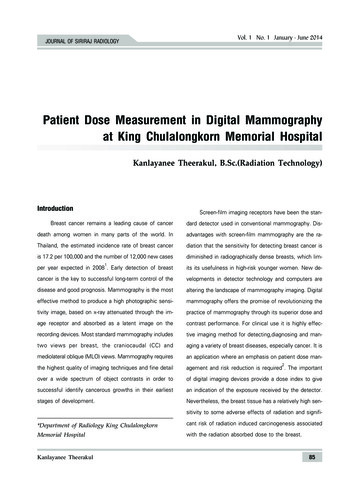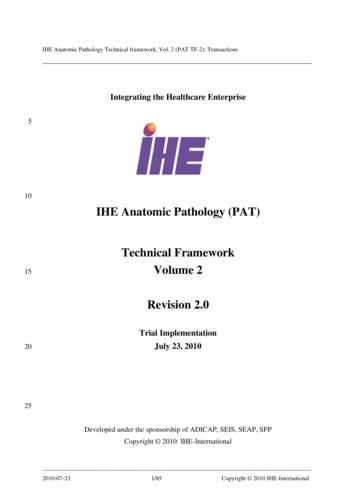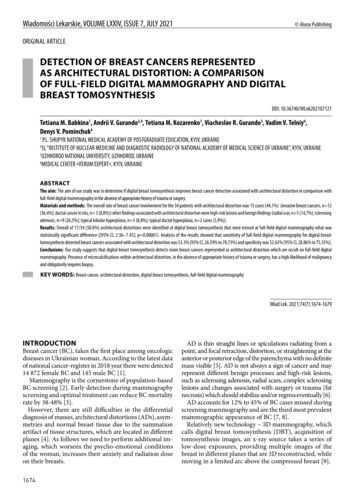
Transcription
Digital Mammography
SSA01Science Session with Keynote: Breast Imaging (Multimodality Screening)Sunday, Nov. 27 10:45AM - 12:15PM Room: Arie Crow n TheaterBRDMAMA PRA Category 1 Credits : 1.50ARRT Category A Credits: 1.50FDADiscussions may include off-label uses.ParticipantsRachel F. Brem, MD, Washington, DC (Moderator) Board of Directors, iCAD, Inc; Board of Directors, Dilon Technologies LLC; Stockoptions, iCAD, Inc; Stockholder, Dilon Technologies LLC; Consultant, U-Systems, Inc; Consultant, Dilon Technologies LLC;Consultant, Dune Medical Devices LtdMaxine S. Jochelson, MD, New York, NY (Moderator) Nothing to DiscloseSub-EventsSSA01-01Breast Imaging Keynote Speaker: Multimodality Screening Part 1Sunday, Nov. 27 10:45AM - 10:55AM Room: Arie Crow n TheaterParticipantsRachel F. Brem, MD, Washington, DC (Presenter) Board of Directors, iCAD, Inc; Board of Directors, Dilon Technologies LLC; Stockoptions, iCAD, Inc; Stockholder, Dilon Technologies LLC; Consultant, U-Systems, Inc; Consultant, Dilon Technologies LLC;Consultant, Dune Medical Devices LtdSSA01-02A Prospective Blind Evaluation of a 3D Functional Infrared Imaging for Risk Assessment in Women atHigh Risk for Breast CancerSunday, Nov. 27 10:55AM - 11:05AM Room: Arie Crow n TheaterParticipantsMiriam Sklair-Levy, MD, Tel -Hashomer, Israel (Presenter) Nothing to DiscloseEitan Friedman, MD, ramat gan, Israel (Abstract Co-Author) Nothing to DiscloseAnat Shalmon, Ramat Gan, Israel (Abstract Co-Author) Nothing to DiscloseArie Rudnstein, MD, TelHashomer, Israel (Abstract Co-Author) Nothing to DiscloseYael Servadio, MD, ramat gan, Israel (Abstract Co-Author) Nothing to DiscloseMichael Gotlieb, MD, ramat gan, Israel (Abstract Co-Author) Nothing to DiscloseDavid Izhaky, PhD, Airport City, Israel (Abstract Co-Author) Employee, Real Imaging LtdPURPOSEThree-dimensional functional infrared imaging (3DIRI) has been shown before to provide high accuracy risk assessment for thelikelihood of breast cancer based on multiparametric evaluation of metabolic imaging biomarkers. In this prospective, blind study, ofhigh risk women, 3DIRI is added twice yearly to a screening program which includes annual breast MRI and breast ultrasound ormammography surveillance. This study evaluates the diagnostic accuracy of 3DIRI’s risk assessment in the screening program andpopulation of high risk women.METHOD AND MATERIALSFollowing IRB approval, 226 female at high risk for breast cancer due to genetic predisposition, mainly known carriers of BRCA 1/2mutation signed informed consent for this study. They underwent one, two or three rounds of screening during 24 months.Screening included 3DIRI scan and MRI or breast Ultrasound or Mammography (FFDM). All examinations were read by one of 5breast radiologists. Women with a negative screening mammography or ultrasound, but positive 3DIRI’s risk assessment score (e.g.likelihood for cancer), were referred to MRI. The sensitivity, specificity, positive predictive value (PPV), and negative predictivevalue (NPV) were analyzed.RESULTS226women completed one, two or three rounds of screening for a total of 378 valid 3DIRI examinations over a period of two years.In 8 women a total of 8 histology confirmed cancers were detected. 3DIRI’s risk assessment was positive (likelihood for cancer) inseven of these women, yielding a sensitivity, specificity, PPV and NPV of 87.5%, 84.32%, 10.77% and 99.68% respectively. Inthree women, cancer was missed by mammography and ultrasound, however, correctly classified as suspicious by 3DIRI and wasdetected by a subsequent MRI.CONCLUSION3DIRI can provide risk assessment for the likelihood of cancer with high accuracy in a population of women that are at high risk forbreast cancer. Additional studies are necessary to evaluate its clinical utilization as adjunct to mammography in women that are athigh risk for breast cancer.CLINICAL RELEVANCE/APPLICATION1.A novel imaging system for assessing the likelihood of breast cancer was developed with high efficacy for correctlyclassified women with breast cancer.2.Assessing the likelihood for breast cancer non-invasively can assist in risk-stratifiedscreening programsSSA01-03The Added Value of Mammography in an Intermediate and High Risk Breast Cancer ScreeningProgramSunday, Nov. 27 11:05AM - 11:15AM Room: Arie Crow n Theater
ParticipantsSuzan Vreemann, MSc, Nijmegen, Netherlands (Presenter) Nothing to DiscloseJan Van Zelst, MD, Nijmegen, Netherlands (Abstract Co-Author) Nothing to DiscloseAlbert Gubern-Merida, PhD, Nijmegen, Netherlands (Abstract Co-Author) Nothing to DiscloseNico Karssemeijer, PhD, Nijmegen, Netherlands (Abstract Co-Author) Shareholder, Matakina Technology Limited Consultant, QViewMedical, Inc Shareholder, QView Medical, Inc Director, ScreenPoint Medical BV Shareholder, ScreenPoint Medical BVRitse M. Mann, MD, PhD, Nijmegen, Netherlands (Abstract Co-Author) Research agreement; Siemens AG; Research agreement, SenoMedical Instruments, IncPURPOSEWomen at increased risk for breast cancer are regularly screened with MRI. In the Netherlands, guidelines state that supplementalmammography is recommended from the age of 30 in these women. The purpose of this study is to investigate the added value ofmammography when breast MRI is available.METHOD AND MATERIALSAn IRB approved, retrospective review of our intermediate and high risk breast cancer screening program was performed, analyzing9582 screening breast MRI examinations and 6555 screening mammograms from 2776 women screened in the period from January2003 to January 2014. Screening indication and age were obtained from patient records. These data were linked to the NetherlandsCancer Registry to identify all breast cancers. Of the cancers identified, imaging records were evaluated for mode and modality ofdetection.RESULTSIn total 179 cancers were identified, of which 137 cancers were screen detected. Thirteen out of 137 were detected bymammography alone (detection rate of 2/1000 screening mammograms). Of those, eight (62%) were found to be ductal carcinomain situ (DCIS). The median age at detection was 55 9.84 years. Twelve (92%) of the breast cancers detected withmammography alone were detected above the age of 40. Three (23%) were detected in BRCA mutation carriers (5% of all screendetected cancers in BRCA mutation carriers). Two of those cancers were diagnosed as DCIS in women above the age of 50.CONCLUSIONThe added value of mammography in high risk screening is very limited: only 13/137 (9%) of the screen detected cancers weredetected by mammography alone and most are DCIS. Mammography is especially questionable in women under the age of 40 and inBRCA mutation carriers. Consequently, the age to start mammography in intermediate and high risk screening needs to bereconsidered.CLINICAL RELEVANCE/APPLICATIONThere is no ground for mammography on top of MRI for early detection of breast cancer in women at increased risk below the ageof 40. In older women the added value is still very limited.SSA01-04Interobserver Variability in Detection of Architectural Distortion: Comparison of Digital Mammographyand Digital Breast TomosynthesisSunday, Nov. 27 11:15AM - 11:25AM Room: Arie Crow n TheaterAwardsTrainee Research Prize - FellowParticipantsElizabeth H. Dibble, MD, Providence, RI (Presenter) Nothing to DiscloseAna P. Lourenco, MD, Providence, RI (Abstract Co-Author) Nothing to DiscloseGrayson L. Baird, PhD, Providence, RI (Abstract Co-Author) Nothing to DiscloseRobert C. Ward, MD, Providence, RI (Abstract Co-Author) Nothing to DiscloseArthur S. Maynard III, MD, Providence, RI (Abstract Co-Author) Nothing to DiscloseMartha B. Mainiero, MD, Providence, RI (Abstract Co-Author) Nothing to DisclosePURPOSETo compare interobserver variability in detecting architectural distortion (AD) on digital mammography (DM) and digital breasttomosynthesis (DBT).METHOD AND MATERIALSIRB-approved, HIPAA compliant retrospective search of radiology database at a tertiary breast center for “AD” or “possible AD” onscreening from 3/5/12-11/27/13. Controls were matched for age, side of prior malignancy, side of new malignancy on presentedmammogram, side of prior surgery, and date of mammogram when possible. Patient demographics, imaging findings, pathologyfindings, and follow-up imaging results were recorded. 2 breast radiologists and 2 breast imaging fellows blinded to outcomesindependently reviewed images of 2 patient groups in 4 sessions: Group A DM only, Group B DBT only, then after a 1 month intervalGroup A DBT only, Group B DM only. For each breast, readers recorded presence or absence of AD and confidence in interpretationon a scale of 1-4.Agreement was examined using weighted Kappa. Differences in confidence between DBT vs DM and attendings vsfellows were examined using generalized mixed modeling with sandwich estimation. Agreement was examined for each breast, noteach patient; outcomes are examined by breast but differences between breasts are not anticipated. Unilateral cases wereremoved (n 4).RESULTS59 patients with AD and 59 controls were identified. Mean age was 58.9 (range 42-86) and 57.5 (range 41-77), respectively.79.7%(47/59) of patients with AD and 78.0%(46/59) of controls had heterogeneously or extremely dense breasts. 23.7%(14/59) ofpatients with AD and 25.4%(15/59) of controls had prior surgery. DM interobserver variability was 0.53 and 0.57 for right and leftbreasts, respectively. DBT interobserver variability was 0.72 and 0.69 for right and left breasts, respectively. Agreement was betterfor DBT than DM; confidence was higher with DBT, p .001 (Table 1).
CONCLUSIONDBT decreases interobserver variability and increases reader confidence in the detection of AD.CLINICAL RELEVANCE/APPLICATIONDBT decreases interobserver variability and increases reader confidence in the detection of AD. This may lead to improveddetection of this subtle manifestation of breast cancer.SSA01-05Concordance of Interpretations of Multi-modality Breast Cancer Screening in Women with DenseBreastsSunday, Nov. 27 11:25AM - 11:35AM Room: Arie Crow n TheaterParticipantsJanie M. Lee, MD, Bellevue, WA (Presenter) Research Grant, General Electric CompanySavannah C. Partridge, PhD, Seattle, WA (Abstract Co-Author) Nothing to DiscloseDaniel S. Hippe, MS, Seattle, WA (Abstract Co-Author) Research Grant, Koninklijke Philips NV; Research Grant, General ElectricCompanyChristoph I. Lee, MD, Los Angeles, CA (Abstract Co-Author) Research Grant, General Electric CompanyHabib Rahbar, MD, Seattle, WA (Abstract Co-Author) Research Grant, General Electric CompanyConstance D. Lehman, MD, PhD, Boston, MA (Abstract Co-Author) Research Grant, General Electric Company; Medical AdvisoryBoard, General Electric CompanyJohn R. Scheel, MD, PhD, Seattle, WA (Abstract Co-Author) Research suppor, General Electric CompanyPURPOSETo compare concordance of interpretations for digital mammography (2D) and digital breast tomosynthesis (3D), without and withautomated whole breast ultrasound (ABUS) for screening women with dense breasts and at intermediate to high risk of developingbreast cancer.METHOD AND MATERIALSThis study was HIPAA compliant and IRB-approved. All women received multimodality screening with 2D, 3D, and ABUS. Routine 2Dand 3D views were obtained. The 3D examination consisted of two-view tomosynthesis and synthetic 2D images of each breast.2D and 3D examinations were interpreted by independent readers, with initial BI-RADS assessment (Categories 0, 1, or 2) recorded.Each reader then interpreted the ABUS examination, and provided combined 2D ABUS or 3D ABUS assessments. For examinationswith positive results (BI-RADS 0), recalled lesions underwent further evaluation with diagnostic 2D views, hand-held breastultrasound, or both. The final BI-RADS assessment was recorded. Lesion location, characteristics, and pathology results (forbiopsied lesions) were recorded. Biopsy recommendation rates were compared using Fisher exact tests.RESULTSOf 121 women, mean age was 54 years (range 26-81 years). Forty-three women (36%) had a family history of breast cancer, 25(21%) had a personal history of breast cancer, and 53 (44%) had both. For 2D and 3D alone, the recall rates were 5.0% (6/121)and 3.3% (4/121), respectively. Two women (25%) had lesions recalled by both readers while 6 women (75%) had lesions recalledby only one reader. For combined 2D ABUS and 3D ABUS interpretations, the recall rates were 13% (16/121) and 11% (13/121),respectively. Of women recalled, five ( 21%) had lesions recalled by both readers; the remaining 19 women (79%) had lesionsrecalled by only one reader. The biopsy recommendation rate tended to be higher for lesions recalled by both readers (3/5, 60%)than for lesions recalled by only one reader (3/19,16%), p 0.078. Of 6 biopsies performed, 1 had malignant and 5 had benignpathology results.CONCLUSIONFor multimodality screening with two readers for each woman, the majority of recalls were seen only by one reader. There was atrend towards a higher biopsy recommendation rate for lesions recalled by both readers.CLINICAL RELEVANCE/APPLICATIONWhen adopting a new screening modality, double reading may reduce false-positive recalls during the “learning curve” phase.SSA01-06The Efficacy of 5-Year Consecutive Ultrasound (US) Surveillance for Detection of Axillary Lymph NodeRecurrence in Breast Cancer Patients Treated with Sentinel Lymph Node Biopsy (SLNB)Sunday, Nov. 27 11:35AM - 11:45AM Room: Arie Crow n TheaterAwardsStudent Travel Stipend AwardParticipantsBo Ra Kwon, MD, Seoul, Korea, Republic Of (Presenter) Nothing to DiscloseJung Min Chang, MD, Seoul, Korea, Republic Of (Abstract Co-Author) Nothing to DiscloseSo Min Lee, MD, Seoul, Korea, Republic Of (Abstract Co-Author) Nothing to DiscloseSung Ui Shin, MD, Seoul, Korea, Republic Of (Abstract Co-Author) Nothing to DiscloseSu Hyun Lee, MD, PhD, Seoul, Korea, Republic Of (Abstract Co-Author) Nothing to DiscloseNariya Cho, MD, PhD, Seoul, Korea, Republic Of (Abstract Co-Author) Nothing to DiscloseWoo Kyung Moon, Seoul, Korea, Republic Of (Abstract Co-Author) Nothing to DisclosePURPOSEScreening the axilla remains elective in ultrasound (US) screening for breast cancer and the efficacy of screening US for axillaryrecurrence in breast cancer patients treated with sentinel lymph node biopsy (SLNB) is unclear. The purpose of this study was todetermine the efficacy of screening US in breast cancer patient treated with SLNB for evaluation of recurrences in breasts andaxillae.METHOD AND MATERIALS
A retrospective chart review was performed on 367 consecutive patients who were treated with mastectomy or breast conservingsurgery and SLNB between January and June 2011. Among these, 303 patients who received annual follow-up screening during 5years were included. Whole breast ultrasounds including both breasts, excision sites, and axillae were performed and interpreted byexpert breast radiologists with mammographic information. The cancer detection rate, recall rate, and positive predictive value(PPV3) of biopsies in breasts and axillae were calculated separately on the basis of pathology or follow-up data.RESULTSA total 303 patients underwent 2045 screening US combined with MG during 5-year follow-up period, 12 had recurrences (5.87 per1,000 cases) including one axillary recurrence (0.49 per 1,000 cases), and 8 occurred within the third year and 4 occurred in thefourth and fifth year. Among recurred breast cancers, 8 breast lesions were detected by combined US and MG with 5-yearaccumulated cancer detection rate of 3.91 per 1,000 cases. Axillary recurrence was detected on chest CT scan by minimal sizechange, not by US. During the period, 244 cases were recalled for breast (11.9%), and 33 cases for axillary lesion (1.6%), and USguided biopsy was performed in 38 breasts and 10 axillary findings, respectively. The PPV3 for breast was 26.3%, and 0% for axilla.CONCLUSIONScreening US combined with MG detected 3.91 recurred cancers per 1,000 cases for 5-year follow-up period in breast cancerpatients treated with SNLB. Axillary recurrence was very rare compared to in-breast recurrence and screening the axilla was nothelpful for detecting axillary recurrence, although the recall rate is lower than that of breast lesions.CLINICAL RELEVANCE/APPLICATIONOur study supports the benefit of screening axillae in patient treated with SNLB is minimal, even though the recall rate is not ashigh as screening breasts.SSA01-07Performance Metrics of Screening Tomosynthesis: Analysis by Patient Age and Baseline versusIncidence ExamSunday, Nov. 27 11:45AM - 11:55AM Room: Arie Crow n TheaterParticipantsLiane E. Philpotts, MD, New Haven, CT (Presenter) Nothing to DiscloseXiao Wu, New Haven, CT (Abstract Co-Author) Nothing to DiscloseMadhavi Raghu, MD, New Haven, CT (Abstract Co-Author) Nothing to DiscloseHoward P. Forman, MD, New Haven, CT (Abstract Co-Author) Nothing to DisclosePURPOSEMammographic screening is criticized due to the imbalance of false positives with true positive cancer detection, particularly inyounger women undergoing baseline exams when cancer incidence is lower. Digital breast tomosynthesis (DBT) has lower RR andhigher cancer detection rates (CDR) than 2D mammography. The purpose of this study was to examine the performance metrics ofscreening DBT by patient age and baseline versus incidence screening.METHOD AND MATERIALSA IRB-approved audit of the breast imaging electronic database (PenRad) was performed to identify all DBT screening exams over4-years at our main hospital and 2 satellite offices (total 46,140 exams). The data was sorted by patient age in 5-yr intervals: 4044, 45-49, , 75-79, 80 . True positive, false positive, true negative, and false negative cases were identified and overallsensitivity, specificity and accuracy calculated. The data for baselines was analyzed separately from incidence exams. Statisticalanalyses performed included Chi square, student t and correlation tests.RESULTSThe overall sensitivity, specificity, and accuracy of tomosynthesis screening in all age groups was very high. There was nosignificant correlation found between sensitivity and age. Sensitivity in 40-44 (86.4%) was higher than in the 45-49 group (82.8%).Specificity and overall accuracy increased with age, ranging from 88.7% in 40-44, to 96% in the oldest groups. When comparingbaseline versus subsequent mammography, metrics were significantly worse (p 0.0001). Subsequent mammography had higheraccuracy than baseline in all age groups except 80 . Specifically, RR in baseline 40-44 (20%) was actually lower than other groupsincluding 45-49 (23%) and 50-54 (27%)(p 0.02). The overall accuracy for baseline exams decreased with age significantly with thebest accuracy found in the 40-44 (80%) and the lowest in the 70-74 group (65%) (p 0.05). Importantly, when only incidenceexams were assessed, there were no significant differences in screening outcomes between the 40-44 and the 45-50 groups(p 0.225).CONCLUSIONTomosynthesis screening yields excellent results in all age groups. Although accuracy is slightly lower in younger women, this effectis erased once non-baseline exams are compared.CLINICAL RELEVANCE/APPLICATIONScreening with DBT performs at a high level and with similar accuracy between age groups such that younger women should not bedeterred from undergoing screening.SSA01-08Predictors of Surveillance Mammography Outcomes in Women with a Personal History of BreastCancerSunday, Nov. 27 11:55AM - 12:05PM Room: Arie Crow n TheaterParticipantsKathryn Lowry, MD, Boston, MA (Presenter) Nothing to DiscloseLior Braunstein, MD, Boston, MA (Abstract Co-Author) Nothing to DiscloseKonstantinos Economopoulos, MD,PhD, Boston, MA (Abstract Co-Author) Nothing to DiscloseLaura Salama, MD, Boston, MA (Abstract Co-Author) Nothing to DiscloseConstance D. Lehman, MD, PhD, Boston, MA (Abstract Co-Author) Research Grant, General Electric Company; Medical Advisory
Board, General Electric CompanyJanie M. Lee, MD, Bellevue, WA (Abstract Co-Author) Research Grant, General Electric CompanyG. Scott Gazelle, MD, PhD, Boston, MA (Abstract Co-Author) Consultant, General Electric Company Consultant, Marval BiosciencesIncElkan F. Halpern, PhD, Boston, MA (Abstract Co-Author) Research Consultant, Hologic, Inc; Research Consultant, Real Imaging Ltd;Research Consultant, Gamma Medica, Inc; Research Consultant, K2M Group Holdings, IncJay R. Harris, MD, Boston, MA (Abstract Co-Author) Nothing to DiscloseAlphonse G. Taghian, MD, PhD, Boston, MA (Abstract Co-Author) Nothing to DisclosePURPOSEWomen with a personal history of breast cancer who survive their initial cancer face risk for second breast cancers, includingsubsequent ipsilateral breast tumor recurrence (IBTR) and contralateral breast cancers. The purpose of this study was to identifypredictors of poor mammography surveillance outcomes based on clinicopathologic features.METHOD AND MATERIALSThis study was HIPAA compliant and IRB approved. We performed a retrospective chart analysis on a cohort of women withAmerican Joint Committee on Cancer (AJCC) Stage I or II invasive breast cancer and subsequent local recurrence or contralateralbreast cancer diagnosed from 1997-2014. Information on ER, PR, HER2 status and histologic grade of primary breast cancer (PBC)was used to approximate biologic subtype (Luminal A, Luminal B, Luminal B-HER2, HER2, and Triple Negative subtypes). Poorsurveillance outcome was defined as second breast cancers which were not detected by screening mammography, including intervalcancers (diagnosed within 12 months of a negative screening mammogram) or clinically detected cancers diagnosed without ascreening mammogram within the past year. Chi square statistics and logistic regression were performed to identify predictors ofpoor mammography surveillance outcome, including patient demographics, PBC characteristics, systemic treatment, breast density,and time to second cancer diagnosis.RESULTSThe final cohort included 164 women with IBTR (n 65) or contralateral cancer (n 99). Of these, 124 second cancers weredetected by surveillance mammography, and 40 were detected by breast symptoms. On univariate analysis, poor surveillanceoutcome was associated with age 50 years at primary breast cancer diagnosis p 0.0001), PBC AJCC stage II (p 0.007), andheterogeneously or extremely dense breasts (p 0.04). On multivariate analysis, age 50 years at PBC diagnosis remained the onlysignificant predictor of poor surveillance outcome (p 0.001).CONCLUSIONWomen diagnosed with PBC before the age of 50 are at risk of poor surveillance mammography outcomes, and may be appropriatecandidates for more intensive clinical and imaging surveillance.CLINICAL RELEVANCE/APPLICATIONWomen with primary breast cancer diagnosed before age 50 are less likely to have second events detected by surveillancemammography and may be an important population for more intensive surveillance.SSA01-09Breast Imaging Keynote Speaker: Multimodality Screening Part 2Sunday, Nov. 27 12:05PM - 12:15PM Room: Arie Crow n TheaterParticipantsMaxine S. Jochelson, MD, New York, NY (Presenter) Nothing to Disclose
CESM: Hands-on Workshop: GE Vendor WorkshopSunday, Nov. 27 11:00AM - 12:00PM Room: Booth 5528ParticipantsPARTICIPANTSJordana Phillips, MDPROGRAM INFORMATIONThis one-hour workshop led by a Peer Educator will introduce GE's SenoBright contrast-enhanced spectral mammography (CESM)technology that helps answer cases with inconclusive mammogram and ultrasound findings. Attendees will: Learn the uniquefeatures of GE's dual-energy acquisition Understand how CESM exams are acquired on the SenoClaire system Review clinicalcases on the Seno Iris Workstation software during physician guided hands-on exam ary-b904d22132614dc2b7633ee3b34f22de.aspx
3D DBT: Hands-on Workshop: GE Vendor WorkshopSunday, Nov. 27 3:00PM - 4:00PM Room: Booth 5528ParticipantsPARTICIPANTSBruce F. Schroeder, MDPROGRAM INFORMATIONThis one-hour workshop led by a Peer Educator will introduce GE's SenoClaire breast tomosynthesis including an overview ofdesign elements, and a review of clinical case study presentations covering masses, calcifications, superposition and associatedfindings to increase clinical confidence. Attendees will: Learn the unique features of GE's Tomosynthesis design See how accurateDBT exams are acquired on the SenoClaire system Review clinical cases on the Seno Iris Workstation software during physicianguided hands-on exam ary-b904d22132614dc2b7633ee3b34f22de.aspx
SSE02Breast Imaging (Quantitative Imaging and CAD)Monday, Nov. 28 3:00PM - 4:00PM Room: E450ABRBQDMINAMA PRA Category 1 Credit : 1.00ARRT Category A Credit: 1.00FDADiscussions may include off-label uses.ParticipantsSungheon G. Kim, PhD, New York, NY (Moderator) Nothing to DiscloseRobert M. Nishikawa, PhD, Pittsburgh, PA (Moderator) Royalties, Hologic, Inc; Research Consultant, iCAD, Inc;Sub-EventsSSE02-01Concurrent CAD for Digital Breast TomosynthesisMonday, Nov. 28 3:00PM - 3:10PM Room: E450AParticipantsRichard A. Benedikt, MD, San Antonio, TX (Presenter) Nothing to DiscloseCynthia A. Swann, MD, San Antonio, TX (Abstract Co-Author) Nothing to DiscloseAaron D. Kirkpatrick, MD, San Antonio, TX (Abstract Co-Author) Nothing to DiscloseAlicia Toledano, DSc, Kensington, MD (Abstract Co-Author) Consultant, iCAD, IncSenthil Periaswamy, PhD, Nashua, NH (Abstract Co-Author) Director of Research, iCAD, IncJustin E. Boatsman, MD, San Antonio, TX (Abstract Co-Author) Nothing to DiscloseJonathan Go, Nashua, NH (Abstract Co-Author) Sr. Vice President, iCAD, IncJeffrey W. Hoffmeister, MD, Nashua, NH (Abstract Co-Author) Employee, iCAD, Inc; Stockholder, iCAD, IncPURPOSEDigital Breast Tomosynthesis (DBT) is more accurate than Full-Field Digital Mammography (FFDM) alone, but prolongs reading time.A reader study evaluated the concurrent use of a Computer-Aided Detection (CAD) system to shorten reading time, whilemaintaining performance.METHOD AND MATERIALSA CAD system was developed to detect suspicious soft tissue lesions (masses, architectural distortions and asymmetries) in DBTplanes. Rather than marking lesions, detected locations are extracted from the DBT planes and blended into the corresponding 2Dsynthetic image. Thus, lesions can be efficiently viewed in a CAD-enhanced 2D synthetic image without overlapping tissue. Twenty(20) radiologists retrospectively reviewed 240 cases in a multi-reader, multi-case (MRMC) crossover design. An enriched DBTsample included 67 malignancies in 60 patients and compared reading with CAD versus without CAD. All readers reviewed all caseswith and without CAD in 2 visits separated by a memory washout period of at least 4 weeks. Radiologist performance was assessedby measuring Area Under the Receiver Operating Characteristic (ROC) Curve (AUC) for malignant lesions with CAD versus withoutCAD. Reading time, sensitivity, specificity and recall rate were also assessed.RESULTSReading time improved 29.2% with use of CAD (95% CI: 21.1%, 36.5%; p 0.01). Reader performance was non-inferior with CAD,for non inferiority margin delta 0.05. Average AUC increased by 0.007 (95% CI: 0.013, 0.028; non-inferiority p 0.01), from0.839 without CAD to 0.846 with CAD. Average sensitivity increased with CAD from 0.847 without CAD to 0.870 with CAD (95% CI:-0.006, 0.053); showing a 0.032 increase in average sensitivity for soft tissue densities (95% CI: 0.002, 0.066), from 0.837without CAD to 0.869 with CAD. Average specificity decreased from 0.525 without CAD to 0.507 with CAD (-0.018; 95% CI: -0.041,0.005), and average recall rate for non-cancers increased from 0.476 without CAD to 0.494 with CAD (0.018; 95% CI: -0.005,0.041).CONCLUSIONConcurrent use of CAD results in a 29.2% faster reading time with non-inferiority of radiologist performance compared to readingwithout CAD.CLINICAL RELEVANCE/APPLICATIONConcurrent use of CAD maintains high performance of DBT with a significant reduction in reading time.SSE02-02Dynamic Textural Analysis of Pre-treatment DCE-MRI Predicts Pathological Complete Response toNeoadjuvant Chemotherapy in Breast CancerMonday, Nov. 28 3:10PM - 3:20PM Room: E450AAwardsStudent Travel Stipend AwardParticipantsNathaniel Braman, Cleveland, OH (Presenter) Nothing to DiscloseMaryam Etesami, MD, Cleveland, OH (Abstract Co-Author) Nothing to DisclosePrateek Prasanna, Cleveland, OH (Abstract Co-Author) Nothing to DiscloseChristina Dubchuk, Cleveland, OH (Abstract Co-Author) Nothing to DiscloseDonna M. Plecha, MD, Strongsville, OH (Abstract Co-Author) Research Grant, Hologic, Inc;Anant Madabhushi, PhD, Piscataway, NJ (Abstract Co-Author) Nothing to Disclose
PURPOSEFewer than 30% of breast cancer patients who undergo neo-adjuvant chemotherapy (NAC) prior to surgery achieve pathologicalcomplete response (pCR). A pre-treatment dynamic contrast-enhanced MR imaging (DCE-MRI) biomarker predictive of pCR wouldenable more precise prognosis assessment and NAC targeting. We explore radiomic analysis of computer-extracted dynamic texturefeatures at two DCE-MRI enhancement phases as a means of predicting breast cancer NAC response from baseline imaging.METHOD AND MATERIALS75 1.5T DCE-MRI scans prior to NAC were retrospectively analyzed. 22 patients had histology-confirmed pCR, while 53 had partialor non-response (NR). Computer-extracted texture features (Haralick, Co-occurrence of Local Anisotropic Gradient Orientations(CoLlAGe), and Laws) were separately extracted from initial and peak enhancement phases. The 5 most distinguishing featureswere selected by interaction capping and used to train a random forest classifier in a 3-fold cross-validation setting. Ability topredict pCR was assessed by area under
SSA01-01 Breast Imaging Keynote Speaker: Multimodality Screening Part 1 Sunday, Nov. 27 10:45AM - 10:55AM Room: Arie Crown Theater SSA01-02 A Prospective Blind Evaluation of a 3D Functional Infrared Imaging for Risk Assessment in Women at High Risk for Breast Cancer Sunday, Nov. 27 10:55AM - 11:05AM Room: Arie Crown Theater
